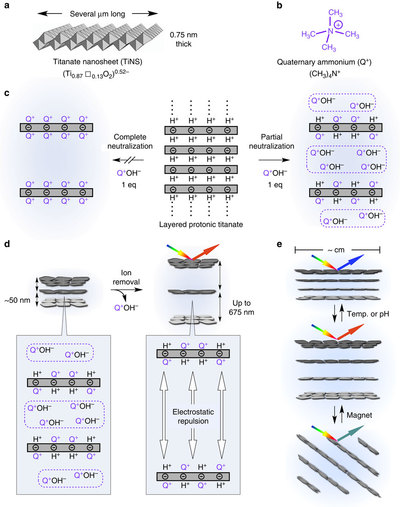PRESS RELEASE
- Research
- 2016
Photonic water dynamically responsive to external stimuli
Authors
Koki Sano, Youn Soo Kim, Yasuhiro Ishida, Yasuo Ebina, Takayoshi Sasaki, Takaaki Hikima & Takuzo Aida
Abstract
Fluids that contain ordered nanostructures with periodic distances in the visible-wavelength range, anomalously exhibit structural colours that can be rapidly modulated by external stimuli. Indeed, some fish can dynamically change colour by modulating the periodic distance of crystalline guanine sheets cofacially oriented in their fluid cytoplasm. Here we report that a dilute aqueous colloidal dispersion of negatively charged titanate nanosheets exhibits structural colours. In this ‘photonic water’, the nanosheets spontaneously adopt a cofacial geometry with an ultralong periodic distance of up to 675 nm due to a strong electrostatic repulsion. Consequently, the photonic water can even reflect near-infrared light up to 1,750 nm. The structural colour becomes more vivid in a magnetic flux that induces monodomain structural ordering of the colloidal dispersion. The reflective colour of the photonic water can be modulated over the entire visible region in response to appropriate physical or chemical stimuli.

(a,b) Schematic illustration of the structure of a negatively charged unilamellar TiNS (a), with quaternary ammonium (Q+; tetramethylammonium) counterions (b). In a, □ indicates a vacant site. (c) Exfoliation of TiNSs from crystals of the layered protonic titanate by treatment with aqueous Q+OH−. States of ions at complete (left) or partial (right) neutralization. (d) Enhancement of the electrostatic repulsion between TiNSs by removal of the free ions (Q+OH−) that screen the electrostatic repulsion, leading to sufficient expansion of the plane-to-plane distance between cofacial TiNSs to permit reflection of visible light (up to 675 nm). (e) Colour modulation of the photonic water by tuning the periodic distance (upper) or the direction (lower) of TiNSs in response to external stimuli.
Nature Communications URL : http://www.nature.com/ncomms/2016/160830/ncomms12559/full/ncomms12559.html

